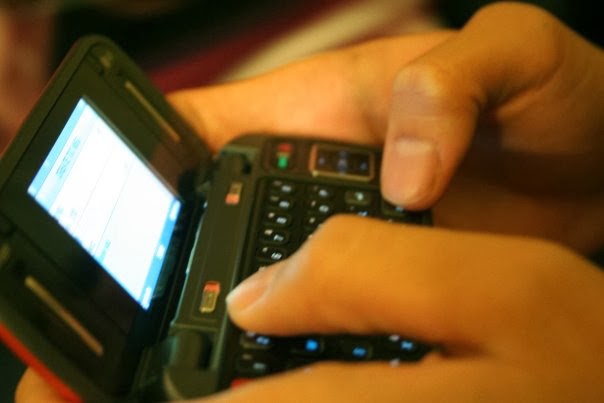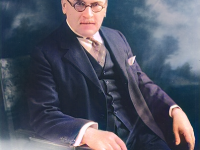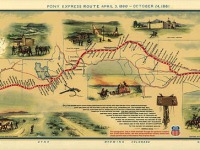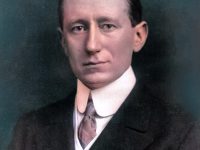
Short Messaging Service (SMS) is one of the most popular network applications, photo: Alton, CC BY 3.0, via Wikimedia Commons
On December 3, 1992, the world‘s first SMS (Short Messaging Service) message was sent from Neil Papworth of Sema Group over the Vodafone GSM network in the United Kingdom. The text of the very first SMS message was simply “Merry Christmas.”
For almost 30 years now we are using this messaging service. Annoyed by the tiny keyboard and by the fact that you have to keep your messages short, because you only have 160 characters available per SMS message. Nevertheless, the SMS was the most popular networked messaging service all around the globe with an estimated 3.5 billion active users in 2010. Although it had its difficulties first to get popular and it’s usage is now declining with the more frequent use of messaging apps like WhatsApp and Telegram, the SMS has been considered to be one of the most important driving forces boosting the popularity of cellphones and mobile devices.
From Telephony to Text
Adding text messaging functionality to mobile devices already began in the early 1980s. The SMS concept was developed in the Franco-German Global System for Mobile Communications (GSM) cooperation in 1984 by Friedhelm Hillebrand and Bernard Ghillebaert. The GSM is optimized for telephony, since this was identified as its main application. The key idea for SMS was to use this telephone-optimized system, and to transport messages on the signaling paths needed to control the telephone traffic during time periods when no signaling traffic existed. In this way, unused resources in the system could be used to transport messages at minimal cost. However, it was necessary to limit the length of the messages to 128 bytes (later improved to 160 seven-bit characters) so that the messages could fit into the existing signaling formats. Based on his personal observations and on analysis of the typical lengths of postcard and Telex messages, Hillebrand argued that 160 characters was sufficient to express most messages succinctly.
Merry Christmas
The technical development of SMS was a multinational collaboration supporting the framework of standards bodies. Through these organizations the technology was made freely available to the whole world. SMS could be implemented in every mobile station by updating its software. Hence, a large base of SMS capable terminals and networks existed when people began to use SMS. The very first SMS message was sent over the Vodafone GSM network in the United Kingdom on 3 December 1992, from Neil Papworth of Sema Group (now Mavenir Systems) using a personal computer to Richard Jarvis of Vodafone using an Orbitel 901 handset. As reported, the text of the message was “Merry Christmas.” Shortly afterwards, the first short message service center (SMSC) was commercially deployed by Aldiscon part of Logica (now part of Acision) with Telia (now TeliaSonera) in Sweden in 1993. The first installations of SMS gateways were for network notifications sent to mobile phones, usually to inform of voice mail messages. The first commercially sold SMS service was offered to consumers, as a person-to-person text messaging service by Radiolinja (now part of Elisa) in Finland in 1993. Most early GSM mobile phone handsets did not support the ability to send SMS text messages, and Nokia was the only handset manufacturer whose total GSM phone line in 1993 already supported user-sending of SMS text messages.
Slow Takeup
Interestingly, initial growth was rather slow, with customers in 1995 sending on average only 0.4 messages per GSM customer per month. One factor in the slow takeup of SMS was that operators were slow to set up charging systems, especially for prepaid subscribers, and eliminate billing fraud which was possible by changing SMSC settings on individual handsets to use the SMSCs of other operators. Initially, networks in the UK only allowed customers to send messages to other users on the same network, limiting the usefulness of the service. By the end of 2000, the average number of messages reached 35 per user per month, and by Christmas Day 2006, over 205 million messages were sent in the UK alone. In 2010, 6.1 trillion SMS text messages were sent. This translates into an average of 193,000 SMS per second. SMS had become a massive commercial industry, earning $114.6 billion globally in 2010.
References and Further Reading:
- [1] LA Times: Why text messages are limited to 160 characters, May 3, 2009.
- [2] Finn Trosby, “the strange duckling of GSM SMS”Archived 2007-09-25 at the Wayback Machine, Telektronikk Vol.3 2004.
- [3] UK hails 10th birthday of SMS, December 2002, The Times of India.
- [4] Kelly, Heather (December 3, 2012). “OMG, The Text Message Turns 20. But has SMS peaked?”. CNN.
- [5] Short Messaging Service at Wikidata






Pingback: Whewell’s Gazette: Year 2, Vol. #21 | Whewell's Ghost